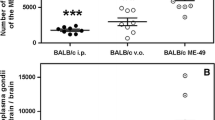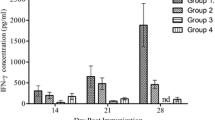Abstract
Parasite-specific IgE antibody response was examined inStrongyloides ratti-infected rats. The results showed that the parasite-specific IgE antibody response was generated after a primary infection. However, repeated infections rather depressed the level of parasite-specific IgE antibody in the serum. Immunization limited to specific stages of the parasite revealed that stimulation of parasite-specific IgE antibody was related to the intestinal adult stage. On the other hand, depression of IgE titers was related to the tissue-migrating larval stage. The capacity of the each stage of the parasite to induce specific IgE response may be related to the variable results of the IgE responses in human strongyloidiasis.
Similar content being viewed by others
References
Bell RG, Adams LS, Gerb J (1981)Strongyloides ratti: Dissociation of the rat's protective immunity into systemic and intestinal components. Exp Parasitol 52:386–395
Bezjak B (1975) Immunoglobulin studies in strongyloidiasis with special reference to raised serum IgE levels. Am J Trop Med Hyg 24:945–948
Capron A, Dessaint JP, Haque A, Auriault C, Joseph M (1983) Macrophages as effector cells in helminth infections. Trans R Soc Trop Med Hyg 77:631–635
Dawkins HJS, Grove DI (1981) Transfer by serum and cells of resistance to infection withStrongyloides ratti in mice. Immunology 43:317–322
Dawkins HJS, Carroll SM, Grove DI (1982) Humoral and cell-mediated immune responses in murine strongyloidiasis. Aust J Exp Biol Med Sci 60:717–729
Genta RM, Ward PA (1980) The histopathology of experimental strongyloidiasis. Am J Pathol 99:207–220
Genta RM, Ottesen EA, Gam AA, Neva FA (1983a) Immunologic responses to experimental strongyloidiasis in rats. Z Parasitenkd 69:667–675
Genta RM, Ottesen EA, Poindexter R, Gam AA, Neva FA, Tanovitz HB, Wittner M (1983b) Specific allergic senistization toStrongyloides antigen in human strongyloidiasis. Lab Invest 48:633–638
Gerbrandy JLF, Bienenstock J (1976) Kinetics and localization of IgE tetanus antibody response in mice immunized by the intratracheal, intraperitoneal and subcutaneous routes. Immunology 31:913–919
Gill GV, Bell DR, Fifield R (1979) Lack of immunoglobulin E response to longstanding strongyloidiasis. Clin Exp Immunol 37:292–294
Goldgraber MB, Lewert RM (1965) Immunological injury of mast cells and connective tissue in mice infected withStrongyloides ratti. J Parasitol 51:169–174
Ikeda T, Fujita K (1980) IgE inParagonimus ohirai-infected rats: Relationship between titer, migration route, and parasite age. J Parasitol 66:197–204
Jarrett EEE (1978) Stimuli for the production and control of IgE in rats. Immunol Rev 41:52–76
Jarrett EEE, Bazin H (1974) Elevation of total serum IgE in rats following helminth parasite infection. Nature 251:613–614
Jarrett EEE, Miller HRP (1982) Production and activities of IgE in helminth infection. In: Kallós P (ed) Immunity and concomitant immunity in infectious diseases. Progress in Allergy vol 31, Karger Basel, p 178–233
Johansson SGO, Mellbin T, Vahlquist B (1968) Immunoglobulin levels in Ethiopian preschool children with special reference to high concentrations of immunoglobulin E (IgND). Lancet I:1118–1121
Korenaga M, Nawa Y, Mimori T, Tada I (1983a) Effects of preintestinal larval antigenic stimuli on the generation of intestinal immunity inStrongyloides ratti infections in rats. J Parasitol 69:78–82
Korenaga M, Nawa Y, Mimori T, Tada I (1983b)Stronglyloides ratti: The role of enteral antigenic stimuli by adult worms in the generation of protective immunity in rats. Exp Parasitol 55:358–363
Mimori T, Nawa Y, Korenaga M, Tada I (1982)Strongyloides ratti: Mast cell and goblet cell responses in the small intestine of infected rats. Exp Parasitol 54:366–370
Moqbel R (1980) Histopathological changes following primary, secondary and repeated infections of rats withStrongyloides ratti, with special reference to tissue eosinophils. Parasite Immunol 2:11–27
Murray M, Jarrett WFH, Jennings FW (1971) Mast cells and macromolecular leak in intestinal immunological reactions. The influence of sex of rats infected withNippostrongylus brasiliensis. Immunology 21:17–31
Murrell KD (1980)Strongyloides ratti: Acquired resistance in the rat to the preintestinal migrating larvae. Exp Parasitol 50:417–425
Murrell KD (1981) Protective role of immunoglobulin G in immunity toStrongyloides ratti. J Parasitol 67:167–173
Nawa Y, Kiyota M, Korenaga M, Kotani M (1985) Defective protective capacity ofW/W v mice againstStrongyloides ratti infection and its reconstitution with bone marrow cells. Parasite Immunol 7:429–438
Ogilvie BM (1967) Reagin-like antibodies in rats infected with the nematode parasiteNippostrongylus brasiliensis. Immunology 12:113–131
Olson CE, Schiller EL (1978)Strongyloides ratti infection in rats. I. Immunopathology. Am J Trop med Hyg 27:521–526
Ovary Z (1964) Passive cutaneous anaphylaxis. Meth Med Res 10:158–162
Radermecker M, Bekhti A, Poncelet E, Salmon J (1974) Serum IgE levels in protozoal and helminthic infections. Int Archs Allergy Appl Immun 47:285–295
Sadun EH (1972) Homocytotropic antibody response to parasitic infections. In: Soulsby EJI (ed) Immunity to animal parasites. Academic Press, New York, p 97
Sheldon AJ (1937) Studies on active acquired resistance, natural and artificial, in the rat to infection withStrongyloides ratti. Am J Hyg 25:53–65
Tada T, Ishizaka K (1970) Distribution of gamma E-forming cells in lymphoid tissues of the human and monkey. J Immunol 104:377–387
Tada I, Mimori T, Nakai M (1979) Migration route ofStrongyloides ratti in albino rats. Jpn J Parasitol 28:219–227
Tada I, Mimori T, Korenaga M, Nakai M (1980) A serological study ofStrongyloides ratti infection in rats. Jpn J Parasitol 29 suppl: 27 (in Japanese)
Tam ND, Papadimitriou J, Keast D (1983) The location of antigenic sites on the surface of the nematode parasiteStrongyloides ratti reactive to antibody-directed cellular cytotoxicity from both macrophages and eosinophils from the natural host. Aust J Exp Biol Med Sci 61:629–636
Author information
Authors and Affiliations
Rights and permissions
About this article
Cite this article
Korenaga, M., Nawa, Y. & Tada, I. IgE response inStrongyloides ratti-infected rats with special reference to the life cycle of the parasite. Z. Parasitenkd. 72, 213–220 (1986). https://doi.org/10.1007/BF00931148
Accepted:
Issue Date:
DOI: https://doi.org/10.1007/BF00931148




